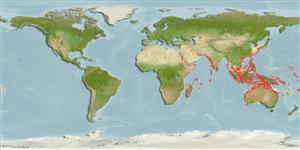Preferred temperature (Ref.
123201): 24.5 - 29, mean 28 °C (based on 766 cells).
Phylogenetic diversity index (Ref.
82804): PD
50 = 0.5000 [Uniqueness, from 0.5 = low to 2.0 = high].
Bayesian length-weight: a=0.01259 (0.00606 - 0.02615), b=3.03 (2.86 - 3.20), in cm total length, based on LWR estimates for this (Sub)family-body shape (Ref.
93245).
Trophic level (Ref.
69278): 4.2 ±0.8 se; based on size and trophs of closest relatives
устойчивость к внешним воздействиям (Ref.
120179): средний (среднего размера), минимальное время удвоения популяции 1.4-4.4 года (Preliminary K or Fecundity.).
Fishing Vulnerability (Ref.
59153): Low vulnerability (15 of 100).
Nutrients (Ref.
124155): Calcium = 59 [31, 117] mg/100g; Iron = 0.683 [0.366, 1.639] mg/100g; Protein = 18 [16, 20] %; Omega3 = 0.223 [0.101, 0.607] g/100g; Selenium = 31.6 [17.1, 77.8] μg/100g; VitaminA = 201 [70, 540] μg/100g; Zinc = 1.22 [0.84, 1.75] mg/100g (wet weight);
